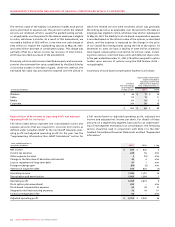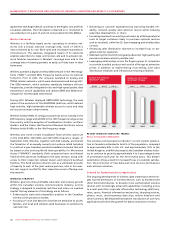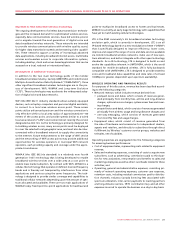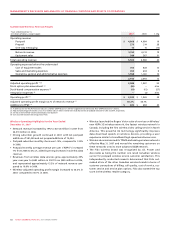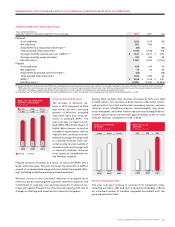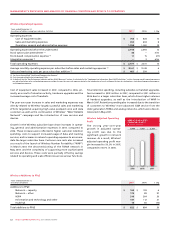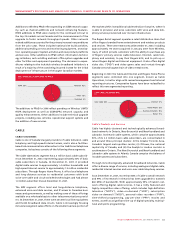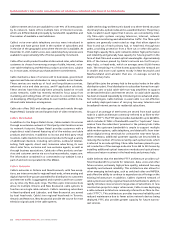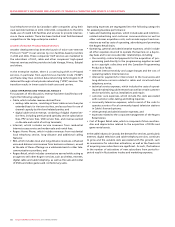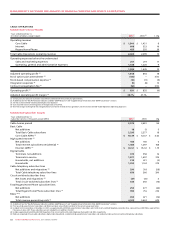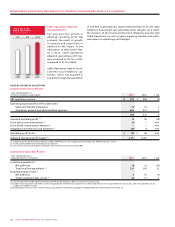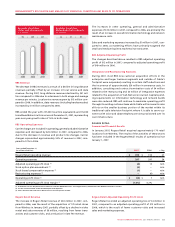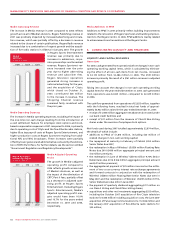Rogers 2007 Annual Report Download - page 38
Download and view the complete annual report
Please find page 38 of the 2007 Rogers annual report below. You can navigate through the pages in the report by either clicking on the pages listed below, or by using the keyword search tool below to find specific information within the annual report.
34 ROGERS COMMUNICATIONS INC. 2007 ANNUAL REPORT
MANAGEMENT’S DISCUSSION AND ANALYSIS OF FINANCIAL CONDITION AND RESULTS OF OPERATIONS
Cable’s Internet services are available to over 97% of homes passed
by its network. Cable offers multiple tiers of Internet services,
which are differentiated principally by bandwidth capabilities and
the number of available e-mail addresses.
Cable’s voice-over-cable telephony services were introduced in
July 2005 and have grown both in the number of subscribers and
in the size of the geographic area where the service is available. At
December 31, 2007, Cable’s voice-over-cable telephony services were
available to approximately 94% of homes passed by its network.
Cable offers multi-product bundles at discounted rates, which allow
customers to choose from among a range of cable, Internet, voice-
over-cable telephony and Wireless products and services, subject
to, in most cases, minimum purchase and term commitments.
Cable maintains a base of services sold to businesses, government
agencies and telecom wholesalers in many markets across Canada.
These services are made up of local and long-distance services,
enhanced voice and data services, and IP application solutions.
These services have historically been primarily based on re-sold
access networks. Cable has recently revised its focus away from
marketing and selling these off-net services to concentrate more
on developing offerings that utilize its own facilities within its tra-
ditional cable television serving areas.
Cable also offers DVD and video game sales and rentals through
Rogers Retail, Canada’s second largest chain of video rental stores.
Cable’s Distribution
In addition to the Rogers Retail stores, Cable markets its services
through an extensive network of third party retail locations across
its network footprint. Rogers Retail provides customers with a
single direct retail channel featuring all of the wireless and cable
products and services. In addition to its own and third party retail
locations, Cable markets its services and products through a variety
of additional channels, including call centres, outbound telemar-
keting, field agents, direct mail, television advertising, its own
direct sales force, exclusive and non-exclusive agents, as well as
through business associations. Cable also offers products and ser-
vices and customer service via our e-business website, rogers.com.
The information contained in or connected to our website is not a
part of and not incorporated into this MD&A.
Cable’s Networks
Cable’s networks in Ontario and New Brunswick, with few excep-
tions, are interconnected to regional head-ends, where analog and
digital channel line-ups are assembled for distribution to customers
and Internet traffic is aggregated and routed to and from custom-
ers, by inter-city fibre-optic rings. The fibre-optic interconnections
allow its multiple Ontario and New Brunswick cable systems to
function as a single cable network. Cable’s remaining subscribers
in Newfoundland and Labrador, and New Brunswick are served
by local head-ends. Cable’s two regional head-ends in Toronto,
Ontario and Moncton, New Brunswick provide the source for most
television signals used in the cable systems.
Cable’s technology architecture is based on a three-tiered structure
of primary hubs, optical nodes and co-axial distribution. The primary
hubs, located in each region that it serves, are connected by inter-
city fibre-optic systems carrying television, Internet, network
control and monitoring and administrative traffic. The fibre-optic
systems are generally constructed as rings that allow signals to
flow in and out of each primary hub, or head-end, through two
paths, providing protection from a fibre cut or other disruption.
These high-capacity fibre-optic networks deliver high performance
and reliability and generally have capacity for future growth in the
form of dark fibre and unused optical wavelengths. Approximately
99% of the homes passed by Cable’s network are fed from pri-
mary hubs, or head-ends, which on average serve 93,000 homes
each. The remaining 1% of the homes passed by the network are
in smaller and more rural systems mostly in New Brunswick and
Newfoundland and Labrador that are, on average, served by
smaller primary hubs.
Optical fibre joins the primary hub to the optical nodes in the cable
distribution plant. Final distribution to subscriber homes from opti-
cal nodes uses co-axial cable with two-way amplifiers to support
on-demand television and Internet service. Co-axial cable capacity
has been increased repeatedly by introducing more advanced ampli-
fier technologies. Cable believes co-axial cable is a cost-effective
and widely deployed means of carrying two-way television and
broadband Internet services to residential subscribers.
Groups of an average of 469 homes are served from each optical
node in a cable architecture commonly referred to as fibre-to-the-
feeder (“FTTF”). The FTTF plant provides bandwidth up to 860 MHz,
which includes 37 MHz of bandwidth used for “upstream” trans-
mission from the subscribers’ premises to the primary hub. Cable
believes the upstream bandwidth is ample to support multiple
cable modem systems, cable telephony, and data traffic from inter-
active digital set-top terminals for at least the near-term future.
When necessary, additional upstream capacity can be provided by
reducing the number of homes served by each optical node, which
is referred to as node-splitting. Fibre cable has been placed to per-
mit a reduction of the average node size from 469 to 350 homes by
installing additional optical transceiver modules and optical trans-
mitters and return receivers in the head-ends and primary hubs.
Cable believes that the 860 MHz FTTF architecture provides suf-
ficient bandwidth to provide for television, data, voice and other
future services, extremely high picture quality, advanced two-way
capability and network reliability. This architecture also allows for
other emerging technologies, such as switched video and MPEG4,
and offers the ability to continue to expand service offerings on the
existing infrastructure. In addition, Cable’s clustered network of
cable systems served by regional head-ends facilitates its ability to
rapidly introduce new services to large areas of subscribers. In new
construction projects in major urban areas, Cable is now deploying
a cable network architecture commonly referred to as fibre-to-the-
curb (“FTTC”). This architecture provides improved reliability and
reduced maintenance due to fewer active network devices being
deployed. FTTC also provides greater capacity for future narrow-
cast services.


